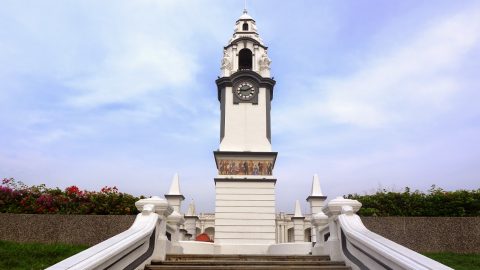Due to the sizeable Chinese populations in Kuala Lumpur and Penang, it is an especially popular festival and both cities are at their busiest in the days leading up to the festival. Malls are packed with shoppers looking for Chinese New Year decorations, stocking up on supplies for open houses and buying new clothes. Yet this is one of the best times to be in Malaysia, with fireworks at night, and informal pedestrian parades outside raucous ‘open houses’.

Chinese New Year History
Legend has it that the Chinese New Year celebrations started due to a fight between villagers and a mythical beast called the Nian. The monster came out on the first day of the New Year to eat the village’s livestock, crops, and even villagers (especially kids). So villagers left food at their front doors to appease the beast, in the hopes that after Nian ate the food it would not attack people. Later on, they found out that Nian was afraid of the colour red and that loud noises frightened it. So every year on the first day of Chinese New Year, they would hang red lanterns and spring scrolls on windows and doors and use firecrackers to scare Nian away. He never came to the village again

Gong Xi Fatt Chai
Each Chinese New Year is given the name of an animal in a 12-year rotation with all having special significance; 2012 is the year of the Dragon. The seasonal Mandarin catchphrase is Gong Xi Fa Chai and the Cantonese version is Gong Hey Fat Choy: it means ‘wishing you a happy and prosperous new year. One of the fun ways to respond to someone who greets you with this salutation is to say Hong Bao Na Lai, which means ‘red envelope please!

Chinese New Year Practices
There are many ways Chinese New Year is observed: most homes spend the week leading up to it cleaning the house to ‘sweep away’ any bad luck and make way for good fortune. Windows and doors are festooned with red decorations and cut-out paper couplets with words such as ‘happiness’, ‘wealth’ and ‘longevity’ to welcome in new luck.
Also, besides prayers and offerings offered to departed ancestors and gifts of ang pow to unmarried relatives, it is customary for Chinese to give money to their favourite local charity; interestingly, most businesses try to clear their debts to make way for good fortune. Fun fact: though Malaysia only has two public holidays for Chinese New Year (the first and second day) the festival officially ends 15 days later with Chap Goh Meh

Reunion Dinner
The eve of the First Day of Chinese New Year sees families having huge get-togethers, called ‘reunion dinners’. They are big feasts with relatives from all over including extended family members (aunties, uncles, cousins). Chinese restaurants cater for these meals or some families opt to have them at home; food served is a wide range of specialty Chinese dishes including pork, duck, chicken and sweet delicacies. These dinners are rowdy affairs with lots of good food and plenty of noise

Open House
Chinese New Year celebrations begin on the first day of the Chinese lunar calendar: this year, the five-day celebration takes place in January. A popular way to celebrate the festival is to have an ‘open house’ with invited guests to these parties including neighbours, office mates, friends and family. Besides a wide spread of the host’s tastiest food and drinks and gifts of mandarin oranges to all present, kids light firecrackers and unmarried visitors are given ang pow (red packets with money). The amount in each ang pow varies; sometimes it is a token sum of two ringgit or more, and at other times close family members will receive larger sums

Dragon and Lion Dances
For foreign visitors this is the best time to catch a free Chinese performance. Besides the good food, some houses even invite lion or dragon dancing troupes to mark the start of Chinese New Year. It is a noisy affair with lots of crashing cymbals, clanging gongs and stylised singing. The night usually ends with a firework display and the next morning is almost Christmas-esque, with children greeting parents a healthy and happy new year and receiving ang pow

Shopping Malls
Since it is an important tradition for new clothes to be worn on the first and second day of the celebrations, it is not a surprise that malls see a lot of visitors (especially on the weekends) in the days leading up to Chinese New Year. As with most major festivals, the festival plays havoc with even the best laid travel itineraries. During the season transport networks are stretched to the limit as countless locals engage in balik kampung (the return to one’s hometown). Plus since the first and second days of Chinese New Year are public holidays, most stores are closed and though traffic within the city is light, nearby major shopping malls it is almost the scene of a disaster movie













Interesting. I wish I were part of the celebration